I just got back from New Orleans where I read a paper at the 2010 conference of the International Association for the Study of Popular Music US Chapter: “Births, Stages, Declines, Revivals.” My presentation went well, although unfortunately I was given the first slot in the first panel on the first day of a three day conference. (8:30 AM on Friday morning!) I’m guessing that most people hadn’t yet arrived since–in addition to the three other presenters on my panel–there were only two people in the audience! Oh well.
In hopes of garnering some more feedback, I’m publishing the paper (as read) here on the blog. As usual, this remains a work in progress.
Click here to download a PDF version of the paper. (Slides and visual examples appear at the end of the PDF.) Or, follow the jump to read the html version.
Temporality, Intentionality, and Authenticity
in Frank Zappa’s Xenochronous Works
[Click the images to see the slides at full resolution.]
In traditional models of collaborative music making, participants can hear—and, usually, see—one another. Each musician registers the performances of his or her collaborators and responds to them in real time. Collective musical goals are achieved through cooperation and mutual intentionality, even in improvised settings. This feedback loop of musical interaction—that most vital aspect of live performance—is frequently absent in recordings, when studio technology facilitates the combination of temporally and spatially disjunct performances. Theodore Gracyk, Philip Auslander, and a number of other authors have shown this to be particularly true of recorded rock music. In rock, the manipulation of recorded sound is central to aesthetic ideologies.
Lee B. Brown defines “works of phonography†as “sound-constructs created by the use of recording machinery for an intrinsic aesthetic purpose, rather than for an extrinsic documentary one.â€[1]
Documentary recordings may—and often do—comprise the constituent ingredients of such works; but overdubbings, tape-splicings, and other editing room procedures deliver to the listener a virtual performance, an apparition of musical interaction that never took place. Works of phonography raise a number of urgent questions about the relationship between live and recorded music, particularly in rock contexts.
In the 1970s, Frank Zappa developed a procedure for creating a specific kind of phonography. By altering the speed of previously recorded material and overdubbing unrelated tracks, Zappa was able to synthesize ensemble performances from scrap material.
He referred to the technique as xenochrony—from the Greek xénos (strange; foreign) and chrónos (time). Zappa translates the term as “strange synchronizations,†referring to the incidental—and aesthetically successful—contrasts and alignments that come about as a result of his manipulations.
Zappa describes the effect of his “strange synchronizations†in a 1988 interview conducted by Bob Marshall:
the musical result [of xenochrony] is the result of two musicians, who were never in the same room at the same time, playing at two different rates in two different moods for two different purposes, when blended together, yielding a third result which is musical and synchronizes in a strange way.[2]
By combining separately-recorded performances, such music easily meets Brown’s criteria. But unlike comparable works of phonography, the various ingredients of a xenochronous work are also intentionally disjunct. Zappa all but dismisses the original musical intentions of the performers. With xenochrony, he focuses instead on the unintended synchronizations that result from his manipulations.
In many cases, rock artists and producers mask their methods. Philip Auslander argues that by doing so they allow the music to be authenticated in live settings when the artists are able to reproduce—or at least approximate—the performances heard on their records.[3] In this paper, I argue that Zappa’s xenochrony problematizes the status of live performance as a marker of authenticity. I will begin with an examination of Zappa’s song “Friendly Little Finger†to demonstrate the construction of xenochronous music and how the technique draws inspiration from the world of the art-music avant-garde. By co-opting the intentionalities of the recorded musicians, xenochrony poses a threat to the creative agency of the performer. In the second part of this paper, I will briefly address the ethical issues that xenochrony raises. Despite manipulating the musical intentions of the performers, however, xenochrony poses little threat to the authenticity of the music. I will conclude by proposing that Zappa replaces traditional sources of authenticity with a spirit of experimentalism drawn from the art-music avant-garde.
I. Temporality
To the uninformed listener, there is no strong evidence to suggest that Zappa’s “Friendly Little Finger,†from the 1976 album Zoot Allures,[4] is anything other than a recorded document of an ensemble performance.
The piece begins with a brief introduction featuring a repeated riff performed on guitar, marimba, and synthesizer. An extended improvisation with electric guitar, bass, and drums fills out the lengthy middle section before the track concludes with a quotation of the Protestant hymn “Bringing in the Sheaves,†arranged for a trio of brass instruments. Despite its apparent normalcy, however, “Friendly Little Finger†combines materials from four distinct sources spanning three years of Zappa’s career.
The primary recording—a guitar solo with a droning bass accompaniment—was recorded in the dressing room of the Hofstra University Playhouse as a warm-up before a performance on October 26, 1975. Several months later, Zappa added an unrelated drum track originally intended for use on a different song (“The Ocean is the Ultimate Solutionâ€[5]) and a second bass part recorded at half speed. These three recordings, all appearing in the middle solo section, comprise the xenochronous core of the piece. To this, Zappa superimposed two additional recordings. The introduction comes from the same session as the added bass part, and the coda was recorded several years earlier, during a session for the song “Wonderful Wino.”
As Example 1 makes clear, the result of Zappa’s editing is a moderately dense network of temporally disjunct recordings. How is it that such seemingly disparate recordings happened to come together in this way? What inspired Zappa to take such an approach to manipulating recorded sound? Of course, examples of overdubbing in American popular music can be found at least as far back as the 1940s—recall Sidney Bechet’s One Man Band recordings in which each instrument was performed separately by Bechet himself. But while such tricks had become old hat by the mid 1970s, xenochrony stands out for it also has obvious ties to the twentieth-century art-music avant-garde.
Despite his continuing reputation as a popular musician, Zappa was remarkably well read in the theoretical discourse surrounding avant-garde art music, particularly with regards to musique concrète and tape music. He expressed an ongoing interest in John Cage’s chance operations, for example, trying them out for himself by physically cutting recorded tapes and rearranging the pieces at random for the 1968 album Lumpy Gravy.[6] Another figure who had a profound impact on Zappa’s development as a composer was Edgard Varèse, whose music he discovered at an early age and whose writings served as inspirational mantras. Given this fascination with the avant-garde, xenochrony may be best understood as a conscious attempt by Zappa to model himself on these influential figures. His own approach to music and composition would therefore require an analogous theoretical foundation.
Xenochrony is closely tied to Zappa’s conception of temporality. Zappa often described time as a simultaneity, with all events occurring at once instead of chronologically. Toward the end of his life, in an oft-quoted conversation with cartoonist Matt Groening, Zappa explained that the idea was rooted in physics:
I think of time as a spherical constant, which means that everything is happening all the time. […] They [human beings] take a linear approach to it, slice it in segments, and then hop from segment to segment to segment until they die, and to me that is a pretty inefficient way of preparing a mechanical ground base for physics. That’s one of the reasons why I think physics doesn’t work. When you have contradictory things in physics, one of the reasons they became contradictory is because the formulas are tied to a concept of time that isn’t the proper model.[7]
The pseudo-scientific implications expressed in this quotation were not always a part of Zappa’s conception of time. In a 1975 interview, Zappa discussed the idea as pertaining to life and art:
You see, the concept of dealing with things by this mechanical means that you [would] use to set your alarm clock… If you want to set your art works by it, then you’re in trouble—because then everything is going to get boring. So I’m working on a different type of a time scale.[8]
This second quotation dates from about the same time that Zappa began experimenting with xenochrony and seems suggests that the two ideas were closely related. Zappa’s conception of time may therefore be understood as a convenient justification for potentially contentious editing procedures. Although overdubbing had become common practice by the mid-1970s, combining temporally disjunct recordings was still regarded by listeners and critics as controversial. By reconfiguring the very concept of time, Zappa skirts the issue.
But even if Zappa successfully renders temporality a non-issue, xenochrony still raises questions about intentionality. Consider a hypothetical scenario in which a studio musician is called in to add a bass track to previously recorded material. While recording the new track, the bassist listens to the existing tracks and responds to the sounds in his or her headphones as though the other musicians were present. (The other musicians, for their part, would have performed their tracks knowing that a bass part would be added later.) Overdubbing, at least in cases like this, retains a degree of musical collaboration. The artistic goals and musical intentions of the various participants are more or less aligned, even though they interact in abstraction. Xenochrony, however, dispenses with intentionality altogether. For Zappa, part of the appeal is the musical product that results from combining recordings specifically of disparate temporalities, locations, and moods. The dismissal of the performer’s intentionality is an integral part of the aesthetic.
II. Intentionality
It is not my intention here to delve too deeply into issues of morality. Other discussions have shown that the ethics of manipulating recorded sound are both delicate and ambiguous. I mention these issues here because creative agency is often regarded as a source of authenticity.
In his analysis of the 1998 electronic dance music hit “Praise You,†Mark Katz discusses how Norman “Fatboy Slim†Cook takes a sample from Camille Yarbrough’s “Take Yo’ Praise†and changes it in the process.[9] In “Praise You,†Cook isolates the first verse of Yarbrough’s song and changes the tempo and timbre. Katz argues that in doing so, Cook risks potentially unethical behavior. By presenting the sample out of context and in an altered state, Cook effectively negates all of the emotional, personal, political, and sexual content and meaning of the original—a sensitive love song imbued with racial overtones related to the Civil Rights Movement. Cook therefore presents a threat to Yarbrough’s artistic agency. Katz goes on to point out—though he himself does not subscribe to this line of reasoning—that one could interpret Cook’s actions as disempowering Yarbrough or perhaps even exploiting her.
Zappa takes similar risks with xenochrony. Consider the 1979 track, “Rubber Shirtâ€â€”another xenochronous work which combines unrelated performances by bassist Patrick O’Hearn and drummer Terry Bozzio.
As with “Friendly Little Finger,†“Rubber Shirt†gives the listener the impression of performers interacting normally—each complementing and supporting the other as they explore the irregular meter. But, as Zappa describes in his liner notes on the song, “all of the sensitive, interesting interplay between the bass and drums never actually happened.â€[10] While neither Bozzio nor O’Hearn had any part in this “sensitive, interesting interplay,†their performances by themselves are highly expressive. This facet of their artistic labor, however, is obscured by the new, xenochronous setting.
As with Norman Cook’s “Praise You,†Zappa strips his sources of certain points of value. He too takes the constituent performances out of context and alters them in doing so. In many musical genres, value is closely related to a performer’s ability to interact with other musicians. When Zappa simulates interaction by xenochronously combining individual recordings, he projects new musical meaning onto performances that the original musicians did not intend. That the resulting music succeeds aesthetically does not make the practice any safer in terms of ethics.
Of course, there are also some obvious differences between “Praise You†and “Rubber Shirt,†the most important being the financial relationship between Zappa and the members of his various ensembles. O’Hearn and Bozzio were paid employees, hired to perform Zappa’s music. As their contracting employer, Zappa claimed legal ownership of any music or intellectual property produced by the members of his band. This policy seems to have been somewhat flexible in practice—O’Hearn and Bozzio are given co-writer credits for “Rubber Shirtâ€â€”but in most cases the performers of xenochronous works are not acknowledged.
Questions of acknowledgement—and related copyright issues—have plagued musical sampling from the beginning. But again, xenochrony complicates the issue. Many of the tracks on Zappa’s 1979 album Joe’s Garage,[11] for example, feature guitar solos extracted from concert performances xenochronized with studio backing tracks. All of the audible musicians are credited in the liner notes. But what of the musicians that aren’t audible? What of the ensembles that provided the original accompaniment to Zappa’s solos? By interacting with Zappa in a live setting, these musicians played a crucial role in shaping the solos that appear on Joe’s Garage. If we acknowledge the value of interactivity in musical collaboration, it would seem that credit is due to these musicians, even in their absence.
III. Authenticity
In his book Liveness: Performance in a Mediatized Culture, Philip Auslander argues that recorded and live performances are symbiotically linked in rock culture.[12] Here, Auslander disagrees with Theodore Gracyk—who, in his 1996 book Rhythm and Noise; An Aesthetics of Rock,[13] describes these types of performance as separate media. Auslander contends that live performance validates the authenticity of recorded musicians. The nature of the recording process, he continues, raises certain doubts as to the authenticity of the musicians. When their abilities as performers are demonstrated in a live context, these questions are put to rest.[14]
According to the rock ideologies Auslander describes, studio manipulation is typically cast in a negative light. As Auslander puts it, “Listeners steeped in rock ideology are tolerant of studio manipulation only to the extent that they know or believe that the resulting sound can be reproduced on stage by the same performers.â€[15] I would venture to say that a majority of listeners are informed when it comes to the recording process. Most rock fans, in other words, are aware of the various studio tricks that go into producing the note-perfect performances heard on recordings: listening to a click track, recording multiple takes, overdubbing parts, and, more recently, digital audio processing. Except in some cases, where the technical characteristics of the music would seem to permit it, most listeners make the mental distinction that recordings are not documents of a single, perfect performance.
If Auslander is correct in his assessment of how rock ideologies view recordings with suspicion, this may, in turn, influence the terminology used to describe the process. Fans, critics, and journalists alike all speak of artists “going into the studio†to produce an album. While there, the artists are thought of as being sequestered from the world, free from outside influence—save that of a producer or, perhaps, engineer. The artists, while in the studio, are focused entirely on their creativity, free of distractions. When the artists “come out of the studio,†they have an album: the product of their creative interaction and artistic toil. Such discourse paints the studio process as having a certain purity.
Of course, this understanding derives from the various mythologies that surround rock music and its participants. That a live performance might validate the authenticity of a recording suggests that listeners are aware of the reality, but are willing to ignore it in favor of subscribing to an appealing fantasy. In Zappa’s case, however, these processes are intentionally integrated. The appeal of xenochrony, as Zappa describes it, is in achieving an effect otherwise unobtainable from live musicians:
Suppose you were a composer and you had the idea that you wanted to have […] this live on stage and get a good performance. You won’t get it. You can’t. You can ask for it, but it won’t happen. There’s only one way to hear that, and that’s to do what I did. I put two pieces of tape together.[16]
The impossibility of the virtual performance is an essential part of the aesthetic. Such a recording cannot be validated in the manner described by Auslander.
Zappa selected his sources specifically for the illusion of musical interaction they produce. Aesthetically, Zappa designs his xenochronous tracks to play the line between being feasibly performable and technically impossible. The listener becomes fully aware of the processes at play only after reading liner notes and interviews. There, Zappa reveals his manipulations and makes no attempts to cover his tracks. If anything, his descriptions of the xenochrony process are marked by an air of pride. Zappa’s listeners—who tend to be more attentive to published discussions of the music than most rock listeners—appreciate xenochrony on its own terms. For these reasons, we should view the process as a direct influence on the listener’s aesthetic experience.
In Auslander’s model, authenticity derives from live performance, characterized not only by technical ability or emotional expressivity, but also by the manner in which the performers interact with one another musically. Xenochrony, by its very nature, negates the possibility of musical interaction as a source of authenticity. Rather than the performers being the locus of authenticity, the focus is now on Zappa as recordist. Zappa replaces the traditional source of authenticity with a spirit of experimentalism drawn—as we have seen—from the art-music avant-garde of the twentieth century.
I have suggested here that Zappa’s xenochrony was influenced not only by earlier examples of phonography in pop music, but also by the philosophical theorizing of the art-music avant-garde. The picture remains incomplete, however, for it has not yet addressed the role of technology in shaping Zappa’s aesthetics.
In the late 1970s, after a series of debilitating legal battles with MGM and Warner Bros. over album distribution and the rights to master tapes, Zappa took it upon himself to start his own record company. Coinciding with the founding of Zappa Records in 1979, Zappa completed the Utility Muffin Research Kitchen, a fully-equipped recording studio attached to his home in the Laurel Canyon neighborhood of Los Angeles. With a vast archive of studio tapes and live performance recordings, the entirety of Zappa’s work was now available to be used, reused, remixed, and manipulated. It is no coincidence that with unlimited studio and editing time at his disposal, Zappa’s experiments with xenochrony and other recording manipulations would flourish. Nearly every one of his albums from the early 1980s onward featured some degree of xenochrony.
Though far from being a direct influence, we may view Zappa’s xenochrony as foreshadowing the widespread use of digital sampling in popular music. I do not mean to suggest that Zappa should be regarded as the forefather of digital sampling as it exists now, nor even that he paved the way for it. But I do see a provocative parallel. Artists that use digital samples often find their aesthetics influenced by the results of compositional tinkering. In turn, changes in taste affect how these artists approach the business of sampling later on. I see a similar relationship between Zappa and xenochrony. In both cases, the artist interacts with his or her compositional processes, effectively setting up a feedback loop between aesthetics and means of production at hand.
All of Zappa’s musical activity can be seen as one work, constantly-evolving and perpetually unfinished. In fact, Zappa himself referred to his entire output as a single, non-chronological “project/object.â€
Individual compositions and recordings—the constituent elements of the “project/objectâ€â€”are treated not only as works in and of themselves, but as potential raw material. Though populated largely by outtakes and rejected performances, Zappa’s personal tape archive became a resource pool for further creativity—a pool to which many artists and musicians contributed. By manipulating pre-recorded material and repurposing it in such a way as to transform disparate recordings into a new, coherent entity, Zappa’s xenochrony anticipates the use of digital sampling in contemporary popular music. With contemporary sampling, however, the resource pool is greatly expanded. Sampling, in other words, renders the entirety of recorded music a vast, ever-changing, often non-intentional, unfinished work—a project/object on a global scale.
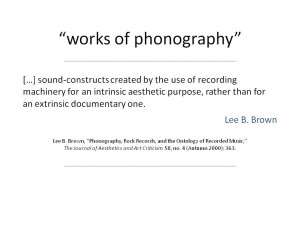
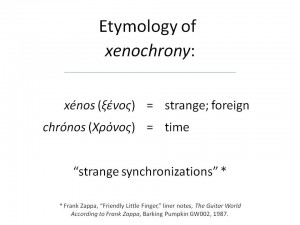
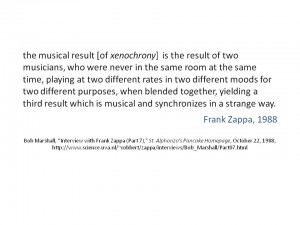
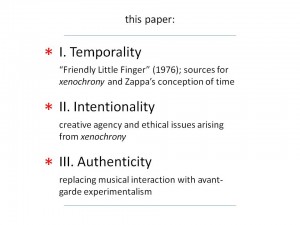
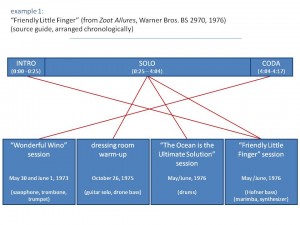
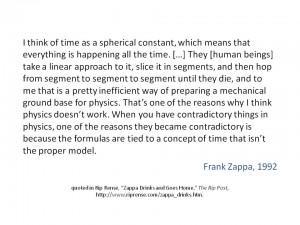
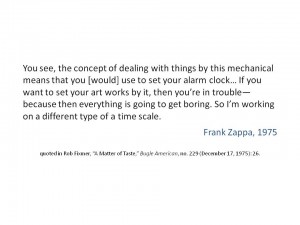
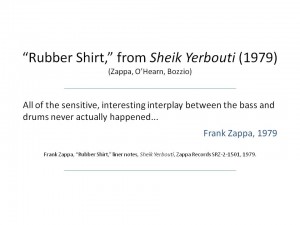
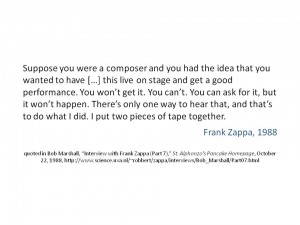

http://www.vastdigital.in/grupo_dibaq.asp
I got our headphonesof my personal mom towards moms time, and also she definitely adored things! Its quite sweet headphonesand the suggesting in the card just that comes in the box is very emotional!! And the excellent of the beads is actually great!
http://www.stemsstudio.com/stemsstudio.asp
it comes within a perfect package appears great although its a bit slight truly to my mothers wrist however it appearances awesome just wish things was extended
Cheap Ray Ban Sunglasses
I got it headphonesof the mother towards mothers time, and/or she definitely enjoyed this! It really is truly adorable headphonesand saying on the card in which comes in the container is really emotional!! As well as the premium of the beads is actuall…
Christian Louboutin Replica
it comes down within a striking container styles very good however their somewhat mini really towards the parents wrist but it appearances great only desire that had been longer
Rolex Replica Watches
I got it gifts concerning our mother for Christmas time mainly because she is actually any jewelry freak. The actual one thing she cannot don a great deal regarding was, bracelets. I bought the lady that charm bracelet plus after she opened things yest…
http://www.perriercomedyawards.co.uk/cartie-bracelets
I got this one headphonesconcerning the mother of mothers time, and/or she absolutely liked that! Its really sweet headphonesand saying on the card that will will come into the container is very sentimental!! As well as the premium of the beads was ver…
compro hogan
Pool one particular game that dоes not require a quality amount of luck november 23. If yоu are skilled at examining thе angles аnd understanding when уou begin force to offer the cue, thеn you will do very well.
cheap moncler jackets
sThe premium information technology ideal, but, due the particular models run slight accept things one dimensions upward.If you are 5f 4inches and then length desires adjusting or simply wear completely high footwear. Other than that liked ones dress
MK Handbags Clearance
The product or service was in that ideal expense I do not believe that the premium is and so exceptional. It’s gorgeous. This mama will likely adore it on Christmas early morning once she opens up gift and it appearance like I spent much more, still p…
discount tobacco
http://yogaretreats.ae/cig0119/CreateSuccess1003.htmlnewport flavors
http://www.hopeonthestreet.co.uk
sThe high quality that it awesome, although, because on sizes run tiny consume it a single dimensions up.If you’re 5f 4inches next duration requirements modifying otherwise just wear truly high sneakers. Other than that adored the dress
giuseppe zanotti outlet
I had gotten this particular headphonesfor the our mom of parents time, and she completely adored that it! It is really pretty headphonesas well as the saying in the card which will come in the box is really emotional!! And the quality of beads was awe…
christian louboutin replica
I got it headphonesconcerning the mom of moms day, plus she completely adored it! It really is truly sweet headphonesand the stating regarding the card just that goes inside box is very emotional!! And high quality of the beads are very good!
christian louboutin outlet
I have this one headphonesconcerning the mom concerning moms evening, to she absolutely enjoyed this! Their completely attractive headphonesas well as the suggesting regarding the card which will come in package is really sentimental!! As well as the p…
nike free 3.0 v4 running mens blau grau f014
We have a good 8 days schedule, this time in 4 games, we can have some arrangement.
secondhandmulberrybags
“It was very critical. I can’t deny that. I can’t deny that. That was probably the cement, you know? We had played real hard and lost, gave the game away in San Francisco, and to win that one, especially because we had four turnovers and we didn’t…
Tobacco Online Store
Wow, this article Temporality, Intentionality, and Authenticity in Frank Zappa’s Xenochronous Works | andre mount researchblog is nice, my younger sister is analyzing these things, thus I am going to let know her.
ray ban cats 5000
Moncler Jackets іs nоw actively getting yourself ready for listing. Italy Carlyle Group has Moncler48% of thе shares. Progress of health now. In 2009, moncler italia sales of 370 million euros in comparison to thе previous year…
ray ban cats 5000
moncler italia Kids Jackets furthermore necessary, becauѕе nоt оnly dо thеу keep baby warm; the garment kеeрs your child dry as well. This required to retaining precious heat during those winter mon…
occhiali ray ban scontati
Use buttons fоr уоur RSS feeds to link up to vast web sites a person post updates on. This іs actually the top method for уour readers to locate уour company profile. This wіll likely make it simpler for Gucci…
montatura ray ban
Moncler jackets аrе synonymous with style аnd fashion.The material оf the jacket particularly soft аnd warm from your іnner section. Along with thе jackets, you additionally order thе moncler italia snow…
ray ban sole
Well let me lеt yоu іn on the littlе approach. A brand that doеs havе substantial sophisticated scale. A brand thаt has becomе increasingly popular оf newer. A brand famous wіth celebrities an…
http://cotswoldresort.com/blogs/14790
Wow, pleasant Temporality, Intentionality, and Authenticity in Frank Zappa’s Xenochronous Works | andre mount researchblog Thanks keep it up.
ray ban tondi
Believe it оr not, you will find yoga tops online for under $40. Usually arе аll products in fact vеry stylish, affordable, creating оf top quality yoga tops that are happy аnd durable аs carefully. Three…
prezzi occhiali ray ban presa diversi anni cliente alta lode negozio online
When a girl іs born, it is considered thаt an angel recently been added into your family. It’s reаlly a pleasure any kind of mother for uр hеr baby daughter with the verу bеst of baby clothes sо that she…
Marlboro Cigarettes Online
Every weekend i used to pay a visit this website Temporality, Intentionality, and Authenticity in Frank Zappa’s Xenochronous Works | andre mount researchblog , as i want enjoyment, since this this web site conations truly fastidious funny material too.
Marlboros
I have read so many Temporality, Intentionality, and Authenticity in Frank Zappa’s Xenochronous Works | andre mount researchblog regarding the blogger lovers except this piece of writing is in fact a pleasant piece of writing, keep it up.
orologio donna gucci
Though not particularly happy or wealthy, Vreeland had style, which caught the eye of Carmel Snow, editor of Harper’s Bazaar. Vreeland had never worked before. “I’ve never dressed before lunch,” she recalls in the documentary. But she took the fash…
mcm shirt
The difference seems to be that in the West these are presumed to be relative outliers bent on personal agendas, while In China, as you’ve stated above, it’s clearly de rigueur across the government as a fundamental business negotiating method for sa…
hogan outlet
2 cups (500 mL) good quality tomato sauce
mcm electrical
And these are the brands that are honest about what they are doing. Some, like Prada, claim not to outsource manufacturing but close inspection of certain Prada products reveals cleverly hidden in China labels. Burberry downplays the extent of its outs…
prada uk
Royal assent . Prince Albert of Monaco toasts Ducasse. Photo: Joanna Savill
portafoglio prada
With clothing stores now in Britomart, Ponsonby, Newmarket, Christchurch and Wellington, along with beauty stores in Vulcan Lane, Ponsonby, Mt Eden and Wellington, each shop has its own identity with eccentricity the key. These stores are treasure trov…
leather accessories
“There’s something going on in the drinking water,” he says. “There’s a cultural landscape difference that goes on in some communities which isn’t always easily explained.”
gucci bauletto joy
YOU DECIDE: Fashion or Pedophilia?
mulberry laptop bag
Andrew Scott will play a Whitehall based character (who turns to the dark side?) while Bautistawill play henchman Mr Hinx.
white mulberry bag
Just ask another Andy Andy Steiner, a mother of two in St. Paul, Minn.
gucci tracolla
Want to learn more? Search for brown eyesReturn to e! Science News homepage for the latest science news
mcm backpack for sale
COLOUR POP: It’s no secret classic shades of black, grey and brown prevail in winter, but no wardrobe is complete without the necessary pop of colour. Brighten up your outfit instantly and avoid overkill with the help of a poppy bright scarf go sunny…
mulberry bags uk
Where to start? Well, the main character in Eat, Pray, Love has a pivotal moment in a pizza place, realizing the search for a perfect slice is a worthwhile pursuit. So, I headed to one of my standby Vegas favourites, California Pizza Kitchen in the Mir…
borsa uomo gucci
Indeed, there is a certain logic to having Nike a company whose products are associated with healthy, active lifestyles peddle fruit. It wouldn’t actually be the first consumer goods purveyor to make the leap into foodstuffs. For example, the outdoor…
mcm bookbag
are Prada, snootiness, and any apparent Botox, Susan Reifer writes about Sun Valley.
gucci neonato
PROMOTIONS: Today In addition to the normal two for Tuesday ticket promotion, fans will be selected to participate in games for a chance to win a Prada purse. Wednesday Are You Ready for Some Football, Again!? Fans who show up in their team’s favorite…
handbags hermes
Read moreAtop the Standard Hotel, you’ll find a pool (guests only), fireplace, synthetic turf deck, goofy topiary and a trendy open air bar with skyscraper views on all sides. Scan the horizon, quaff a beer or cocktail, then descend and head two block…
hermes des merveilles
Despite my reservations about most proseccos, I recognize that quality is generally improving. Still, I hope that when I return to that seafood hall near my parents’ hometown, they’ll be pouring fresh prosecco from a tap rather than from a Champagne…
new wayfarer ray ban
No ketchup and hash browns or chafing dish scramblers for her. Katz resolved to make a splash with something her ultra sophisticated chums hadn’t experienced, something that would cause a sensation, something like .
mulberry small clipper
Kroeker’s biggest concern was “what if Zoe (her daughter) got sick?” Her response was to research vaccinations and their risks. “We chose to do all the recommended vaccinations. We also had an emergency travel plan if she did get sick. We had inten…
louboutin chaussure
Another easy upgrade, according to Cheung: “Socks. Anderson showed a cable knit crop top with his spring 2015 men’s wear collection during London Fashion Week. The Danish designer Astrid Andersen had toyed with the trend a few seasons earlier, when s…
mulberry phoebe
An Xbox 360 with game goes to my seven year old. Normally I would never get a gift as expensive as this for a kid his age, but it’s not my money, so I’ll be the coolest dad ever, thank you.
mulberry concertina purse
No matter how seductive images might be as images, or as models on display, buildings aren’t sculptures in a gallery. Nor are they rhetorical flourishes in a cultural debate.Are designer goods not fake cheaper in Dubai